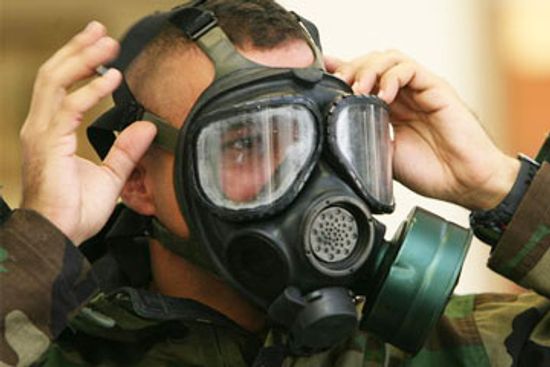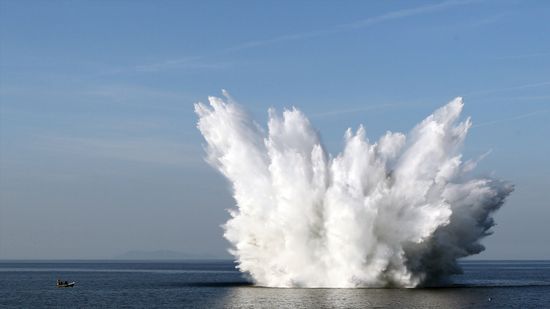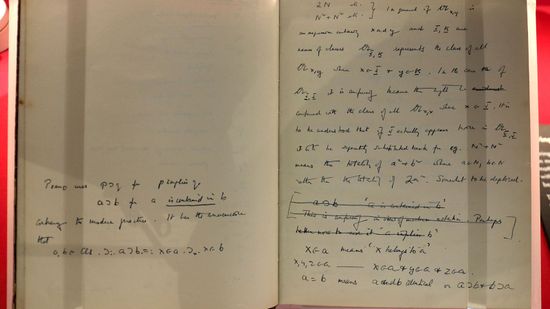Firearms
Firearms are one of the oldest and most evolved weapon systems. From flintlocks to automatic weapons and flamethrowers, learn how firearms have been used to wage wars and save lives.

Watch Your Six: Military Jet Pictures

McDonnell Douglas F-4 Phantom II

Lockheed P-38 Lightning

Does Army experience help your civilian career?

How NCO Professional Development Ribbons Work

How Army Reconnaissance Jobs Work

How Agent Orange Worked

How Biological and Chemical Warfare Works

How Mustard Gas Works

What Is the Strongest Military in the World?

5 Countries That Ditched Their Military Forces

Coast Guard Rescue Swimmers Risk All to Save Lives

Anatomy of an Underwater Explosion

Can You Really Outrun an Explosion?

How Blast-resistant Clothing Works

Are robots replacing human soldiers?

Can drones replace fighter jets?

Do wars drive technological advancement?

Submarine Pictures

How the Zumwalt Class Destroyer Works

How Aircraft Carriers Work

How Military Video Conferencing Works

Why a Draft Would Weaken the U.S. Military

What Was the First War?

Top 5 Gadgets on the High-tech Soldier

Ghillie: Fishing Aid and Inspiration for Camo Suits

10 Insane Disguises That Actually Worked

How Code Breakers Work

YOU Can Drive a Tank!

Is the army testing an invisible tank?

Centurion Main Battle Tank
Learn More
HowStuffWorks explains two ways that gun owners are modifying their semi-automatic weapons to fire like automatic ones.
Guns come in all shapes and sizes. Put on your safety gear and take a look at this gallery of revolvers, Glocks, shotguns and even flamethrowers.
By Rick Mayda
Sure, G.I. Joe's accoutrements are tiny, but this itty bitty gun actually fires rounds. What is it, and why is it illegal to import into the United States?
By Josh Clark
Advertisement
If you could build a train that could travel as fast as a bullet, what would happen if you fired a gun from the back of the train ... or from the front of the train?
By Yara Simón
The invention of the machine gun forever changed the battlefield. While soldiers once had to reload after a single shot, they now can fire hundreds of rounds per minute without a single pause.
When humans discovered fire, they learned to cook their food in a controlled environment. What came next? Flamethrowers, of course. What do flamethrowers have in common with their living counterpart -- fire breathers?
By Tom Harris
The revolver turned shooting a round into a one-step process, forever changing the face of crime, law enforcement and self-defense. Find out what goes on inside a revolver.
By Tom Harris
Advertisement
Whether they're antique rifles or modern handguns and shotguns, firearms are popular in the United States. So which pieces are people packing?
Flintlock guns were extremely important weapons in the American Revolution; they also formed the foundation of all modern guns. Learn about the gun that started it all.
How in the world can a gun silencer work? How can you possibly take an explosive noise that can damage your hearing and turn it into a little "ffft" sound?
If you've ever watched a gun fired into the air at a celebration, you've probably wondered where that bullet ends up. We've got the answer.
Advertisement
To do its job, a projectile must both make contact with the target and hit the target in a critical spot. If a rifle is like using a felt-tip pen, a shotgun is like using a can of spray paint.
By Dave Coustan
Guns permeate society -- police officers carry them, wars are fought with them, normal citizens own them. These articles will show you how different types of guns function from trigger to barrel.
High-profile shootings often make people wonder if the victim or victims would still be alive if no guns had been available. But is that true? Are people more reckless simply because they have a gun?
Firearms get the historical spotlight, but what about the projectiles they hurl at insane speeds? Here are the innovations that gave rise to modern ammunition. Think of it as 10 rounds of ammo info.
Advertisement
Would you believe there are videos showing toddlers opening gun safes? Turns out some of them are not very secure. Why is that, and what should you look for when buying one?
By Julia Layton
The term "semi-automatic weapon" is used in the U.S. media often. But what does it really mean? Is it just another term for a machine gun?
By Chris Opfer
For instance, gun silencers don't make guns all that quiet.
By Dave Roos
Would populations boom and violence cease? Or would humans and human nature essentially remain the same?
Advertisement
President Joe Biden announced new regulations surrounding ghost guns. What are these untraceable guns that allow a purchaser to assemble them from parts?
Without question, they save lives - but they aren't 100 percent failsafe.
The ArmaLite AR-15 rifle has become a hot-button issue in the American landscape. Where did the rifle originate and how did it become so controversial?





















